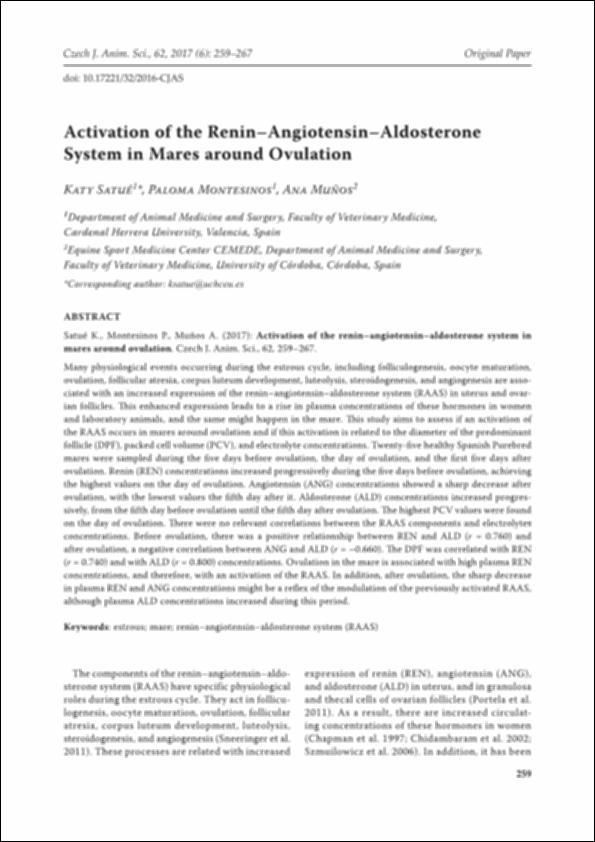Please use this identifier to cite or link to this item:
http://hdl.handle.net/10637/14158Activation of the renin-angiotensin-aldosterone system in mares around ovulation
| Title: | Activation of the renin-angiotensin-aldosterone system in mares around ovulation |
| Authors : | Satué Ambrojo, Katiuska Montesinos Herrero, Paloma Muñoz Juzado, Ana |
| Keywords: | Horses - Generative organs.; Hematología veterinaria.; Horse breeds - Spanish - Reproduction.; Horse breeds - Spanish - Hematology.; Caballos - Razas - Española - Aspectos bioquímicos.; Caballos - Razas - Española - Reproducción.; Veterinary physiology.; Angiotensina.; Caballos - Razas - Española - Hematología.; Hormonas animales.; Hormones.; Horse breeds - Spanish - Biochemical aspects.; Fisiología veterinaria.; Veterinary hematology.; Caballos - Aparato genital.; Angiotensin.; Aldosterona.; Aldosterone. |
| Publisher: | Czech Journal of Animal ScienceCzech Academy of Agricultural Sciences |
| Citation: | Satué, K., Montesinos, P. & Muñoz, A. (2017). Activation of the renin–angiotensin–aldosterone system in mares around ovulation. Czech Journal of Animal Science, vol. 62, i. 6 (30 jun.), pp. 259-267. DOI: https://doi.org/10.17221/32/2016-CJAS |
| Abstract: | Many physiological events occurring during the estrous cycle, including folliculogenesis, oocyte maturation, ovulation, follicular atresia, corpus luteum development, luteolysis, steroidogenesis, and angiogenesis are associated with an increased expression of the renin–angiotensin–aldosterone system (RAAS) in uterus and ovarian follicles. This enhanced expression leads to a rise in plasma concentrations of these hormones in women and laboratory animals, and the same might happen in the mare. This study aims to assess if an activation of the RAAS occurs in mares around ovulation and if this activation is related to the diameter of the predominant follicle (DPF), packed cell volume (PCV), and electrolyte concentrations. Twenty-five healthy Spanish Purebred mares were sampled during the five days before ovulation, the day of ovulation, and the first five days after ovulation. Renin (REN) concentrations increased progressively during the five days before ovulation, achieving the highest values on the day of ovulation. Angiotensin (ANG) concentrations showed a sharp decrease after ovulation, with the lowest values the fifth day after it. Aldosterone (ALD) concentrations increased progressively, from the fifth day before ovulation until the fifth day after ovulation. The highest PCV values were found on the day of ovulation. There were no relevant correlations between the RAAS components and electrolytes concentrations. Before ovulation, there was a positive relationship between REN and ALD (r = 0.760) and after ovulation, a negative correlation between ANG and ALD (r = –0.660). The DPF was correlated with REN (r = 0.740) and with ALD (r = 0.800) concentrations. Ovulation in the mare is associated with high plasma REN concentrations, and therefore, with an activation of the RAAS. In addition, after ovulation, the sharp decrease in plasma REN and ANG concentrations might be a reflex of the modulation of the previously activated RAAS, although plasma ALD concentrations increased during this period. |
| Description: | Este artículo se encuentra disponible en la siguiente URL: https://cjas.agriculturejournals.cz/pdfs/cjs/2017/06/05.pdf |
| URI: | http://hdl.handle.net/10637/14158 |
| Rights : | http://creativecommons.org/licenses/by-nc/4.0/deed.es |
| ISSN: | 1212-1819 1805-9309 (Electrónico) |
| Language: | es |
| Issue Date: | 30-Jun-2017 |
| Center : | Universidad Cardenal Herrera-CEU |
| Appears in Collections: | Dpto. Medicina y Cirugía Animal |
Items in DSpace are protected by copyright, with all rights reserved, unless otherwise indicated.


